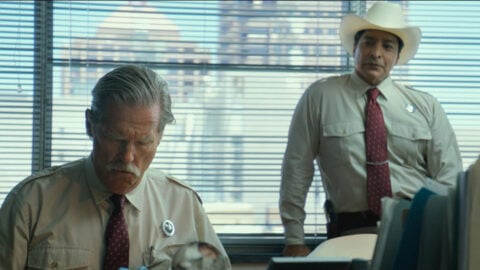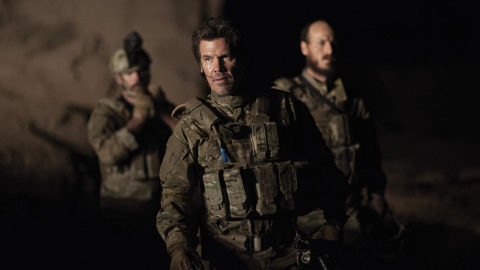Deep Focus: Wind River
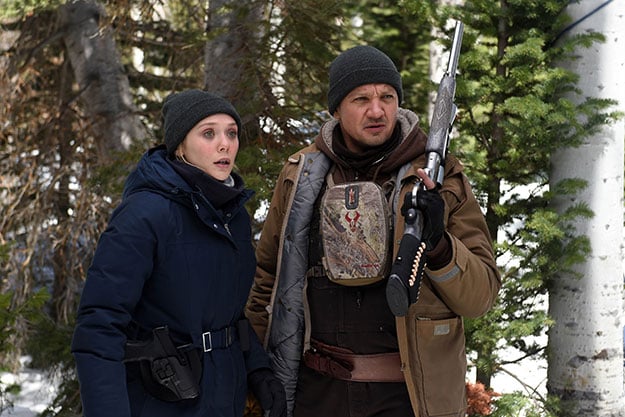
Taylor Sheridan directed a cheapo horror movie in 2009 called Vile, but it’s his success as a screenwriter that has earned him the right to strike out on his own as a writer-director with Wind River, a topical murder movie with an exorbitant ratio of corpses to characters. Wind River takes off from the rampant violence and criminality raging through the Arapaho and Shoshone populations on the frigid Wind River Reservation in Wyoming, covered in The New York Times five years ago under the headline, “Brutal Crimes Grip an Indian Reservation.” Sheridan has grabbed at some risky, juicy subject matter. Each volatile element gets its moment in cold bright sun and bracing moonlit nights: the reservation is ravaged by unemployment, anomie, sexual abuse, and drugs, and surrounded by drilling company employees who don’t give a frack about the Native American population. But Sheridan can’t get his writing arm around all this hopelessness and degradation. His script contains rudimentary elements of follow-the-clues mysteries and life-or-death wilderness adventures, but it never coheres into a taut, compelling line of action. Wind River ultimately aims to be an existential survival movie, but that aim is rarely true.
With just two films, the narco-drama Sicario (2015), about the ruthlessness of drug lords, and the message Western Hell or High Water (2016), about the rapaciousness of banks, actor-turned-writer Sheridan has won a reputation for screenplays that to his fans are tense, colloquial, and witty and to his few detractors are pompous and schematic. I semi-enjoyed Sicario because of the cunning stagecraft director Denis Villeneuve applied to showdowns and chases, and I found Hell or High Water watchable because director David Mackenzie sustained an acerbic tone, glided past absurdities, and fleshed out themes about morality and justice with Jeff Bridges and Gil Birmingham. For critics like me, Sheridan’s didactic streak, which is as long as the Rio Grande, drowns out his newfangled frontier archetypes and nifty down-home dialogue.
Even at a routine 107 minutes, Wind River feels both skinny and padded, like its untested FBI agent, Jane Banner (Elizabeth Olsen), who shows up during a blizzard in flimsy Las Vegas duds and must don a borrowed quilted snowsuit. Apparently, she’s the Fed closest to the reservation when the tribal police call for help on a possible murder. Or else she’s expendable enough to park on a reservation scandalously underserved by every branch of government.
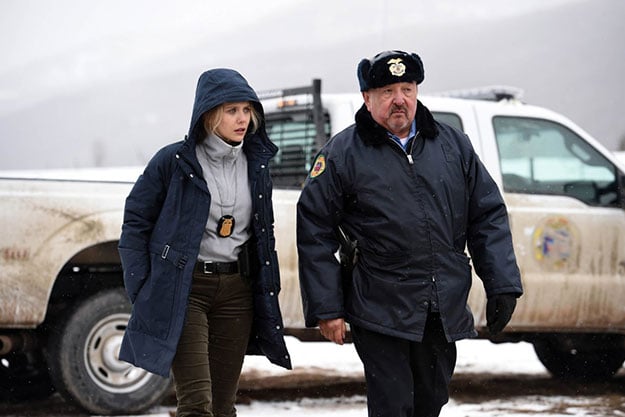
Jane’s fish-out-of-ice-water scenario requires her to partner with the reservation police chief, Ben (the formidably wise and droll Graham Greene) and an Anglo animal tracker and hunter for (presumably) both Wyoming Game and Fish and U.S. Fish and Wildlife, Cory Lambert (that master of grit and verisimilitude, Jeremy Renner). Cory is the one who, early on, finds the dead 18-year-old, Natalie (Kelsey Asbille), in a vast frozen meadow, resolving to crack the case and punish those responsible. Not only does he know Natalie’s parents (Gil Birmingham and Althea Same) but his own teenage daughter, Natalie’s best friend, also died mysteriously out in the cold.
Sheridan’s cruel symmetry is designed to suggest how prevalent violence against women is on or just outside the reservation, and how pitiless the environment can be, especially to an adolescent or barely adult female running for her life. But Sheridan teases out the revelations about Cory’s past more like a dramatic ecdysiast (go ahead: look it up) than a latter-day tragedian.
Cory acts like a great guy and loving parent. In the film’s most charming, lyrical scene, he teaches his young son, Casey (Teo Briones), horsemanship with a tender eye and an easy touch. So when his Arapaho ex-wife, Wilma (Julia Jones), gets curt with him and comments ominously about her never setting foot in a certain town again, we guess that their daughter, whom we see memorialized in photos, didn’t die of natural causes—and that Wilma holds Cory responsible. The movie is being advertised as a “thriller,” but it’s really more like Manchester by the Sea transplanted to Wyoming scrubland.
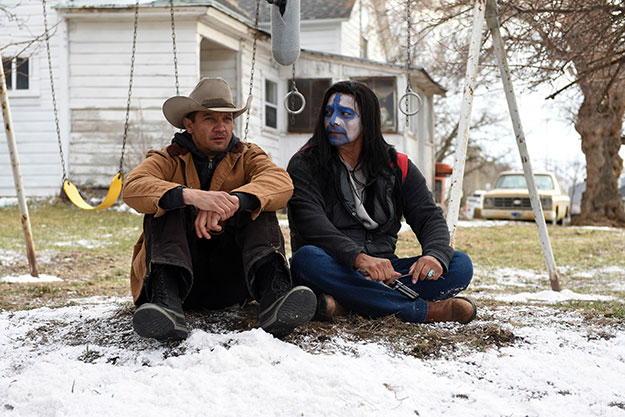
This melancholy murk acts like a psychological wet blanket on what could have been a crackling whodunit. The achingly slow reveal of Cory’s past does nothing to heighten or illuminate the present drama. Sheridan mistakes withholding and then abruptly delivering information for dramatically building toward a payoff. When Sheridan decides to come clean about Cory’s sorrowful past or Natalie’s murder, the results are like emotion-streaked information dumps.
Not even Renner always transcends Sheridan’s preachiness about endurance or the plight of the reservation. When Cory relates the lessons he took from grief counseling—acknowledging that he’ll never feel whole again, needing to forgive himself, giving himself permission to remember and to suffer—Renner’s passion can’t redeem the generic language. If theatrical qualities could be bought and sold, this would be over-the-counter O’Neill. Still, Sheridan does hand Renner some showcase moments. The best comes when the ludicrously naïve Jane asks Cory how well he knows the landscape, and Cory, deliciously dry, says that it’s his job.
That matter-of-fact conviction, with glimmers of pride and bravado, could be Renner’s signature response. No one else can play a modern workingman with as much ease and texture, slipping into pursuits as different as bomb-defusing (The Hurt Locker, 2011) and theoretical physics (Arrival, 2016) as naturally as he dons a new field or lab uniform. He’s tops when it comes to expressing the union of physical and mental exertion with emotional drive. He was equally credible as an obsessed investigative journalist in Kill the Messenger (2014) and as Hawkeye in Marvel’s Avengers movies, a super-Everyman with a mental balance to match his perfect archer’s aim.
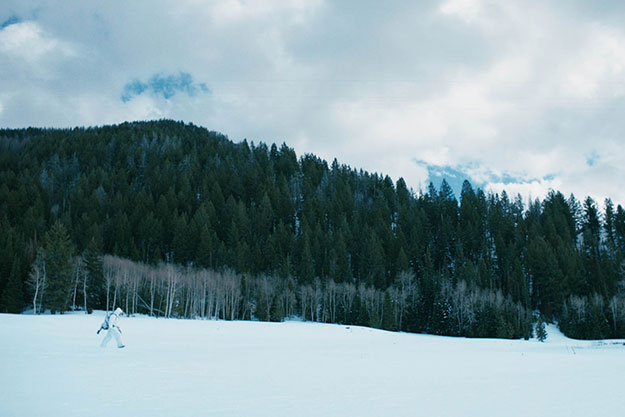
In Wind River, in cowboy hat and togs or a white camouflage suit, he uses the same intense and practical eye to study crime scenes as grim and debasing as a rural drug pad and as pristine as a snow-capped ridge. He turns spotting snowmobile tracks through binoculars into a quietly charismatic act. Unfortunately, the detective work never gets more intricate or challenging. In a less self-serious movie, Renner could have sustained a seriocomic “me Cory, you Jane” kind of chemistry with Olsen, who does give an alert and responsive performance: she’s wide-awake and authentic despite the recurring cluelessness of her character. In fact, Olsen is so good she gives us whiplash—her root intelligence and honesty as a performer make it hard to accept that Jane could be insanely heartless to the dead woman’s parents or recklessly inept with her law-and-order allies. (If I read the action correctly, her bad calls lead to a wholesale slaughter.) Renner still manages to be touching when he bares his soul to her and funny when, in consideration of her Florida roots, he presents her with a stuffed crocodile, or, as she notes, “alligator.”
Sheridan’s gifted Native American actors get some wonderfully sardonic rhythms going, including Birmingham, whose bereaved father admits he has no idea what it means after he paints himself into a self-styled “Death Face.” Greene corrals the most memorable lines, quipping that the rich people’s estates in Jackson, Wyoming, will go “for pennies on the dollar” once “wolves start eating their Golden Retrievers.” Greene pulls off a reversal of “serious” Westerns’ reverence for stolid, noble Indians. He puts an irreverent deadpan spin on Sheridan’s sharpest dialogue. At one point, our heroine ponders whether she should wait for backup, and Ben replies, “This isn’t the land of backup, Jane. This is the land of you’re on your own.”
At his peak, Sheridan has a talent for putting an edge on plain speaking. But it’s premature for him to be making films on his own. His Wind River screenplay needed a strong director, both to impose an expressive visual style and more urgency and clarity on the human interplay. Cinematographer Ben Richardson contributes handsome snow-blown panoramas, evocative details, like a spider skittering across the snowpack, and some haunting compositions, like the shadowy shot of a mountain-lion lair. Occasionally he and Sheridan score a coup. It’s startling when they follow police chief Ben’s complaint that in Wyoming you must travel 50 miles to go five with an aerial view of that route “as the crow flies.”

The film, though, degenerates into slabs of brutality with an awkward explanatory flashback that brings in an entire crew of diaboli ex machinis and an artless climactic shootout. As a thriller that intends to deliver a message by uncovering the vicious secrets of a hermetic, lawless town, Wind River is no Bad Day at Black Rock (1955). John Sturges’s genre classic was virtuoso broad-stroke fiction, but it skillfully focused attention on U.S. treatment of Japanese-Americans during World War II.
Wind River ends with the legend, “While missing person statistics are compiled for every other demographic, none exist for Native American women. No one knows how many are missing.” But the movie hasn’t lived up to those words. The strongest female Indian character is the murdered teenager, who gets one death scene and one flashback. It’s as if Sheridan had discovered his most potent theme after he completed the movie. Maybe what Wind River needed was a rewind.
Michael Sragow is a contributing editor to Film Comment and writes its Deep Focus column. He is a member of the National Society of Film Critics and the Los Angeles Film Critics Association. He also curates “The Moviegoer” at the Library of America website.



